As the Tudor dynasty came to an end, Britain went through a period of upheaval with events such as the execution of Charles I and civil war, through to the great fire of London and glorious revolution which saw William and Mary ascend to the throne in place of James II. Just as Dutch royalty had an influence over the British monarchy in the latter half of the century, Dutch and Flemish artists had a strong impact on the creative output – especially in the field of portraiture which captured the image of all major players from this troubled period, from the austere face of Oliver Cromwell to the court beauties of Charles II.
 Above: a 17th century portrait before and after fire damage restoration, completed by our conservation team in 2020
Above: a 17th century portrait before and after fire damage restoration, completed by our conservation team in 2020
Two of the most influential figures in 17th century British art were also ‘Principal Painter in Ordinary’ to the crown, producing numerous portraits of royalty and members of the court or aristocracy throughout their career. Anthony van Dyck and Peter Lely not only dominated the style of portraiture in their own lifetime but inspired the next generation of artists in the enlightenment of the 18th century. This article will cover some of the emblematic styles you may come across in these influential portraits, as well as the ways in which they can be sensitively and professionally cared for by our 21st century conservators.
 Above: 17th century portraits can become yellow over time due to the natural composition of their varnish darkening as it ages
Above: 17th century portraits can become yellow over time due to the natural composition of their varnish darkening as it ages
How to identify a 17th century portrait
One of the easiest ways to establish an era in portraiture is to focus on the fashion of the sitter. Eary 17th century portraits may begin with similar fashions to that of the Elizabethan age, with highly starched collars known as farthingales and rigid corsets, sometimes adorned with floral embroidery. By the 1620s new styles emerged, including a soft lace collar that draped the shoulders. In this decade you will notice the dresses become much more voluminous and the large sleeves may be tied just above the elbow with a complimentary ribbon called a ‘virago’.
 Above: a portrait by Rembrandt with a detail of the fashionable Dutch lace collar and ribbons on the elbows and waist
Above: a portrait by Rembrandt with a detail of the fashionable Dutch lace collar and ribbons on the elbows and waist
Paned sleeves can be found on both men and women, with panels of segmented fabric running from a broad upper arm to a tighter wrist, known as a ‘leg-of-mutton’ shape. As well as a fuller appearance, the waistline of a dress may also be a lot higher than that of the Elizabethan style. During the 1630s high waists became more of a standard.
 Above: a portrait by van Dyck featuring paned sleeves which are tied with a virago
Above: a portrait by van Dyck featuring paned sleeves which are tied with a virago
When war began to spread across Europe in the middle of the century, including the English civil war from 1642 to 1651, you may notice more of a military presence in male portraiture. This includes armour, such as a body plate or weapon in hand, as well as the cavalier style which may feature aspects such as voluminous sleeves, double jackets, white linen shirts, a lace collar that spreads shoulder to shoulder, leather boots, and a feathered hat. Women’s fashion of this period features a wider and lower neckline.
 Above: a portrait by van Dyck displaying the typical cavalier style
Above: a portrait by van Dyck displaying the typical cavalier style
Hairstyles in the 17th century saw a growing trend of ringlets on women with a flat style on top. For men, shoulder-length hair and a ‘van Dyck’ style facial hair are dominant, this is a combination of a moustache and goatee with all other beard hair cleanly shaven.
 Above: a detail from a portrait by Hendrick Munnichhoven featuring a typical 17th century hairstyle
Above: a detail from a portrait by Hendrick Munnichhoven featuring a typical 17th century hairstyle
By the 1670s onwards the new baroque style begins to take hold, there is more use of brocade and less focus on the lace collars which had previously dominated clothing. Hair became more likely to be decorated with ribbons and pearls and eventually gave way to curled wigs being used instead of natural hair. By this point in the century, commerce for fashionable goods became more accessible with all manner of accessories, shoes, hats and wigs being made available at haberdasheries for the middle and upper classes. By the late 17th century, lace headdresses were popular across Europe.
 Above: a portrait from the 1670s by Giovanni Battista Gaulli displaying the use of lace later in the century
Above: a portrait from the 1670s by Giovanni Battista Gaulli displaying the use of lace later in the century
Beware that some later centuries may show men, women and children in older attire, as the style of ‘van Dyck portraiture’ may have come back into fashion in various decades. When this is the case, you should be able to identify the era through other means if there is no label, such as the canvas texture, stretcher bars, pigments, and artistic style. A 17th century painting will have much older and less well-cut stretcher bars than those from the 19th century onwards.
 Above: a detail from a Dutch family portrait by Charles Le Brun from 1660
Above: a detail from a Dutch family portrait by Charles Le Brun from 1660
Influential 17th century portrait artists
Born in Antwerp at the turn of the century, Anthony van Dyck received training in the studio of Peter Paul Rubens before moving to London to become the court painter for Charles I. Along with Velazquez in Spain, he was one of the revolutionary court painters of his day and continued to influence many artists decades after his death.
 Above: a detail from van Dyck’s portrait of Lord Wharton from 1632
Above: a detail from van Dyck’s portrait of Lord Wharton from 1632
Van Dyck’s most iconic portraits include Portrait of Mary, daughter of Charles I with her husband the Prince of Orange from 1641, Marie-Louise de Tassis from 1630, Charles I with M. de St Antoine from 1633, Charles I in Three Positions from 1635 and The five eldest children of Charles I from 1637.
 Above: a painting by van Dyck before and after being restored in our studio
Above: a painting by van Dyck before and after being restored in our studio
Peter Lely followed in the footsteps of Anthony van Dyck, born in Westphalia to Dutch parents, he studied in Haarlem – a city that played an important role in the Dutch golden age. After the restoration of the monarchy, Lely was court painter to Charles II. This glamorous court inspired some of his most famous works, including the Windsor Beauties – a series from the 1660s of the ladies of Charles II’s court, some of whom were royal mistresses, they are shown in both fashionable attire and in the style of classical figures.
 Above: a detail from Peter Lely’s portrait of Mary Capel, Later Duchess of Beaufort, and Her Sister Elizabeth, Countess of Carnarvon
Above: a detail from Peter Lely’s portrait of Mary Capel, Later Duchess of Beaufort, and Her Sister Elizabeth, Countess of Carnarvon
Lely’s work was extremely popular, to the point a system was put in place to help his studio produce many hundreds of portraits. Lely would take notes of the facial features and hands of his subject, they were placed in a numbered set of poses with what as often a draped classical background – palatial pillars with hanging silks before an idyllic landscape. When Lely passed away in 1680, his position was taken over by Godfrey Kneller, who continued many of these composition practices and styles. Lely left a large collection of art which included pieces by the artists who inspired him, including Titian, Giorgione, Guido Reni, Veronese, Frans Hals and Rubens.
Further 17th century artists working in the genre of portraiture include:
- Sir Godfrey Kneller 1646-1723
- Nicolaes Maes 1634-1693
- Diego Velázquez 1599-1660
- Jacob Huysmans 1633-1696
- Mary Beale 1633-1699
- Gerard Soest 1600-1681
- Daniël Mijtens 1590-1648
- Willem Wissing 1656-1687
 Above: an early 18th century Godfrey Kneller portrait before and after restoration by our conservators
Above: an early 18th century Godfrey Kneller portrait before and after restoration by our conservators
17th century portrait restoration
17th century portrait care is affected by their old age, these historic artworks may have faced numerous environments across the last few hundred years, leading to a wide variety of atmospheric damages. The most common form of disturbance is in the discoloured varnish layer of these paintings, which often deteriorate leaving a dark or yellow appearance. They may have also been discoloured due to fireplace smoke and debris in the atmosphere of historic homes, now embedded in the surface. Our conservators use precise and tested treatments to remove old varnish, revealing the bright original colours. This varnish can be replaced in a new, UV protective variety which is non-yellowing.
 Above: a 17th century portrait restored in our studio, here you can see the difference following a varnish removal on a small area (left), halfway through (middle) and after (right)
Above: a 17th century portrait restored in our studio, here you can see the difference following a varnish removal on a small area (left), halfway through (middle) and after (right)
Stretcher bars may have been affected by woodworm or environmental conditions, leaving them weak. A loose or moveable canvas can lead to a cracked or disturbed surface, so needs to be professionally resolved to avoid damage. Original stretcher bars can be stabilised and if necessary they can be replaced with new timber. The oil painting itself may need to be relined onto a new canvas to ensure it is stable, as old paintings may delaminate from their original canvas over time – you can see this in any lifting edges.
Tears to a 17th century painting can be professionally restored with thread-by-thread methods. Even the most devastating torn areas can be resolved by our conservation team who can also stabilise the surface to prevent further paint loss and sympathetically retouch lost areas with tiny amounts of specialist pigment for an even finish.
 Above: a 17th century portrait restored in our studio featuring a tear to the canvas which was seamlessly restored
Above: a 17th century portrait restored in our studio featuring a tear to the canvas which was seamlessly restored
The frame of a 17th century portrait may have deteriorated along with the painting, requiring specialist conservation treatments from our framing experts. A loose or dirty frame will have an impact on the artwork it holds, leading to abrasions to the edges of a painting or the transference of contamination. A weak frame may also be more likely to fall from height, leading to much more intense canvas damage due to tears and distortion. A frame can be gently cleaned with sensitive methods, any missing areas can be reapplied or remoulded, and any gilding can be rejuvenated with either a bright or aged finish.
 Above: a 17th century portrait restored in our studio due to smoke damage
Above: a 17th century portrait restored in our studio due to smoke damage
How can we help?
If you have a 17th century portrait restoration project that may benefit from professional care, please contact our helpful team who will be pleased to assist further.
To make contact please email us via [email protected] or call 0207 112 7576

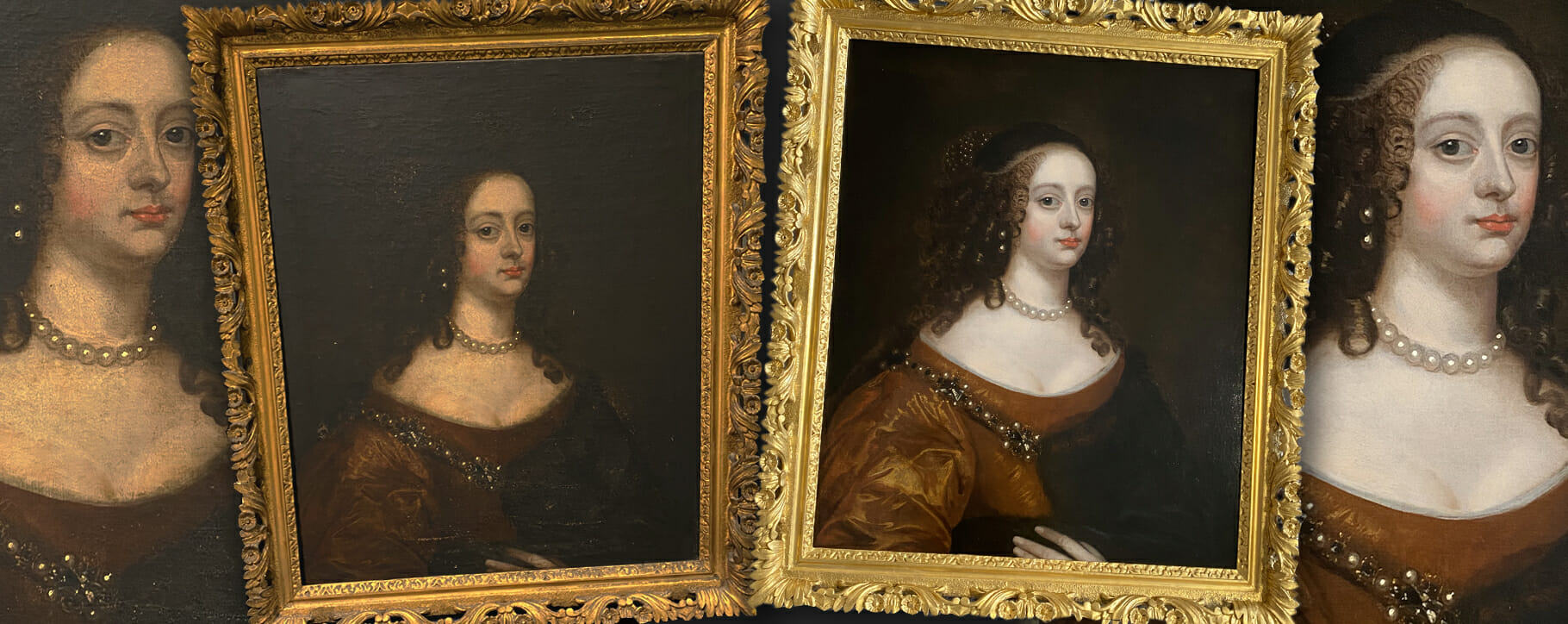 Above: a 17th century portrait before and after fire damage restoration, completed by our conservation team in 2020
Above: a 17th century portrait before and after fire damage restoration, completed by our conservation team in 2020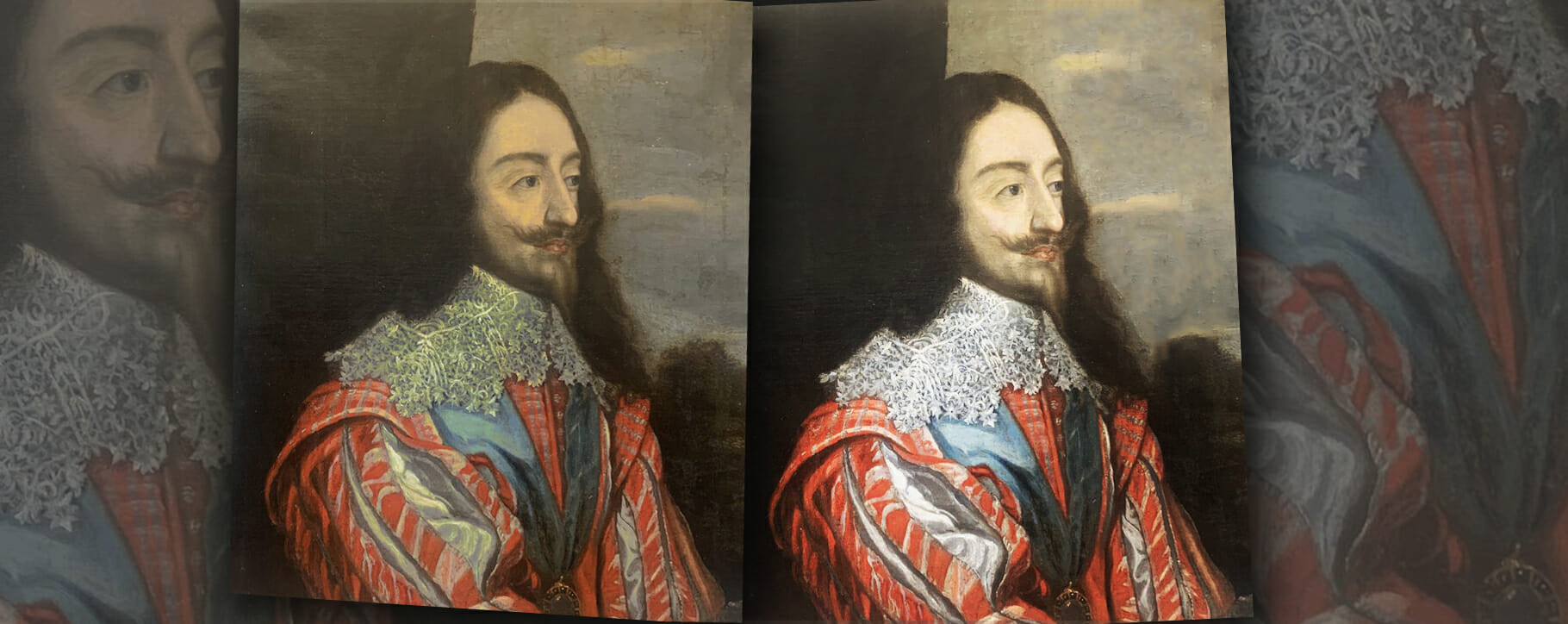 Above: 17th century portraits can become yellow over time due to the natural composition of their varnish darkening as it ages
Above: 17th century portraits can become yellow over time due to the natural composition of their varnish darkening as it ages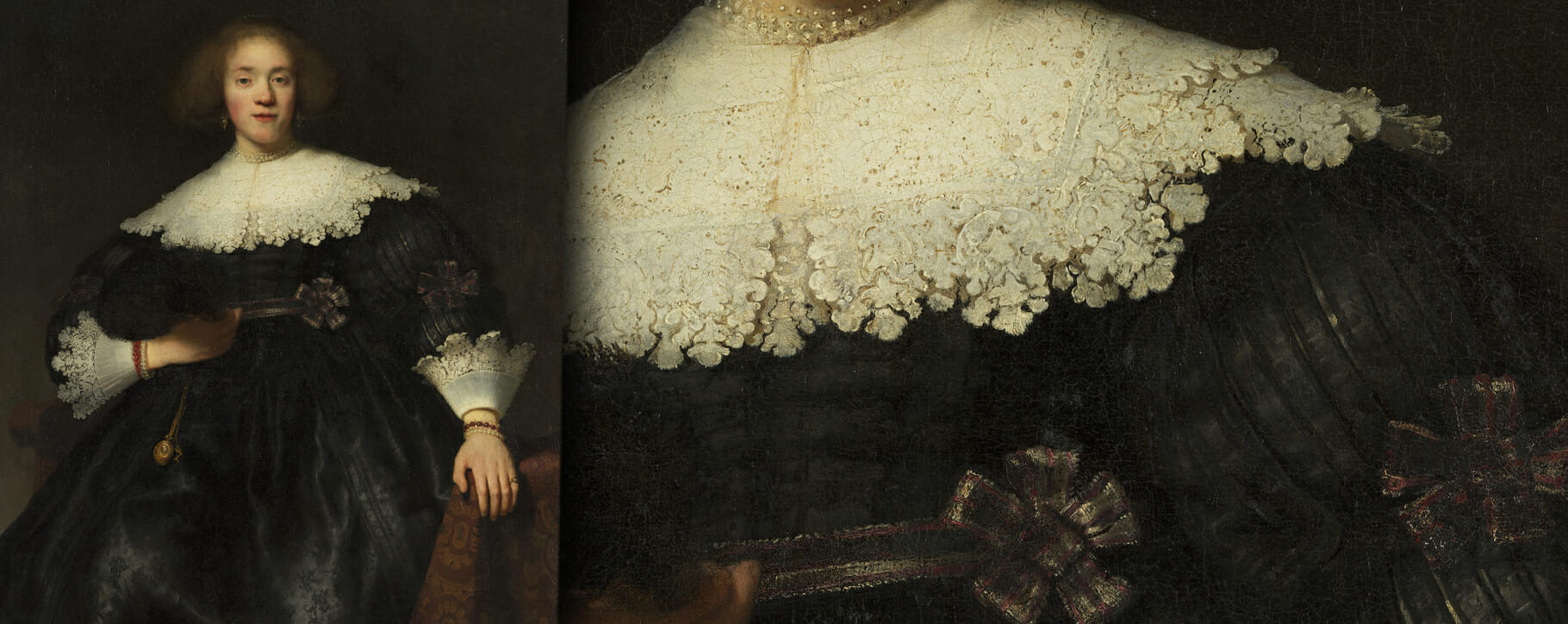 Above: a portrait by Rembrandt with a detail of the fashionable Dutch lace collar and ribbons on the elbows and waist
Above: a portrait by Rembrandt with a detail of the fashionable Dutch lace collar and ribbons on the elbows and waist Above: a portrait by van Dyck featuring paned sleeves which are tied with a virago
Above: a portrait by van Dyck featuring paned sleeves which are tied with a virago Above: a portrait by van Dyck displaying the typical cavalier style
Above: a portrait by van Dyck displaying the typical cavalier style 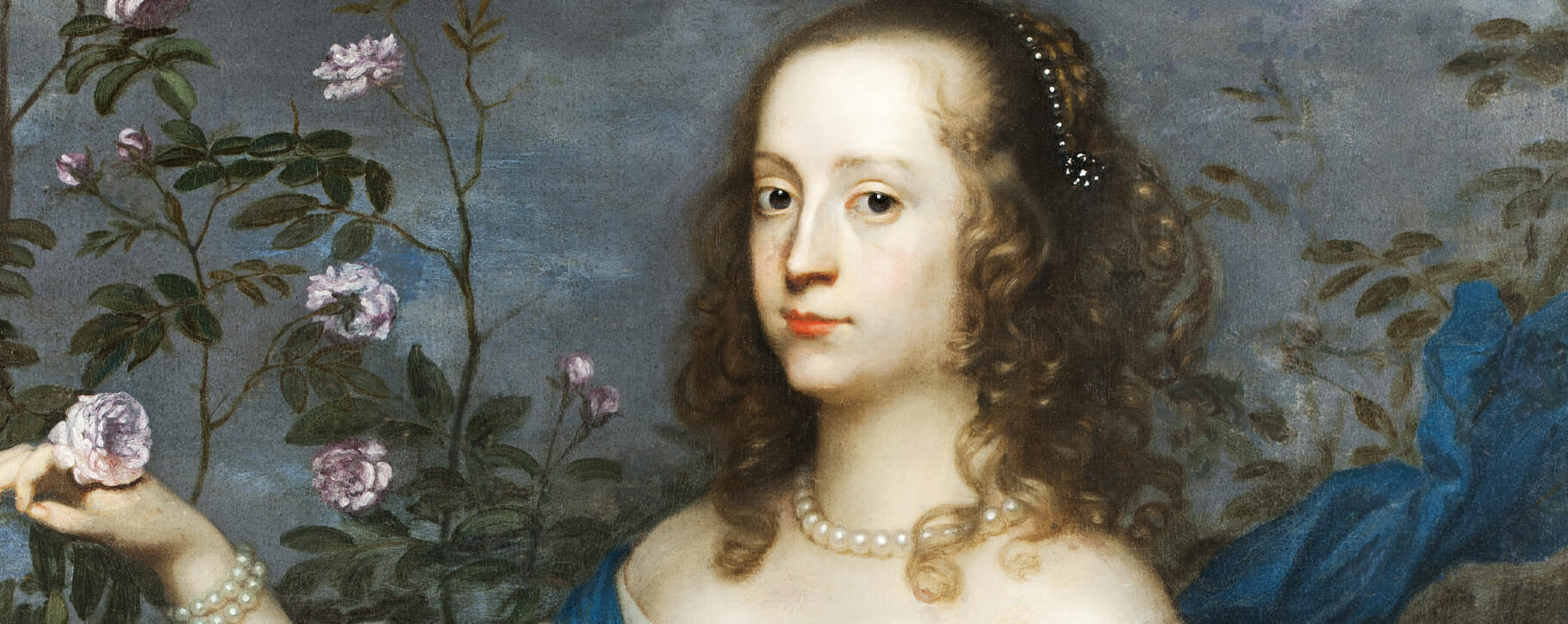 Above: a detail from a portrait by Hendrick Munnichhoven featuring a typical 17th century hairstyle
Above: a detail from a portrait by Hendrick Munnichhoven featuring a typical 17th century hairstyle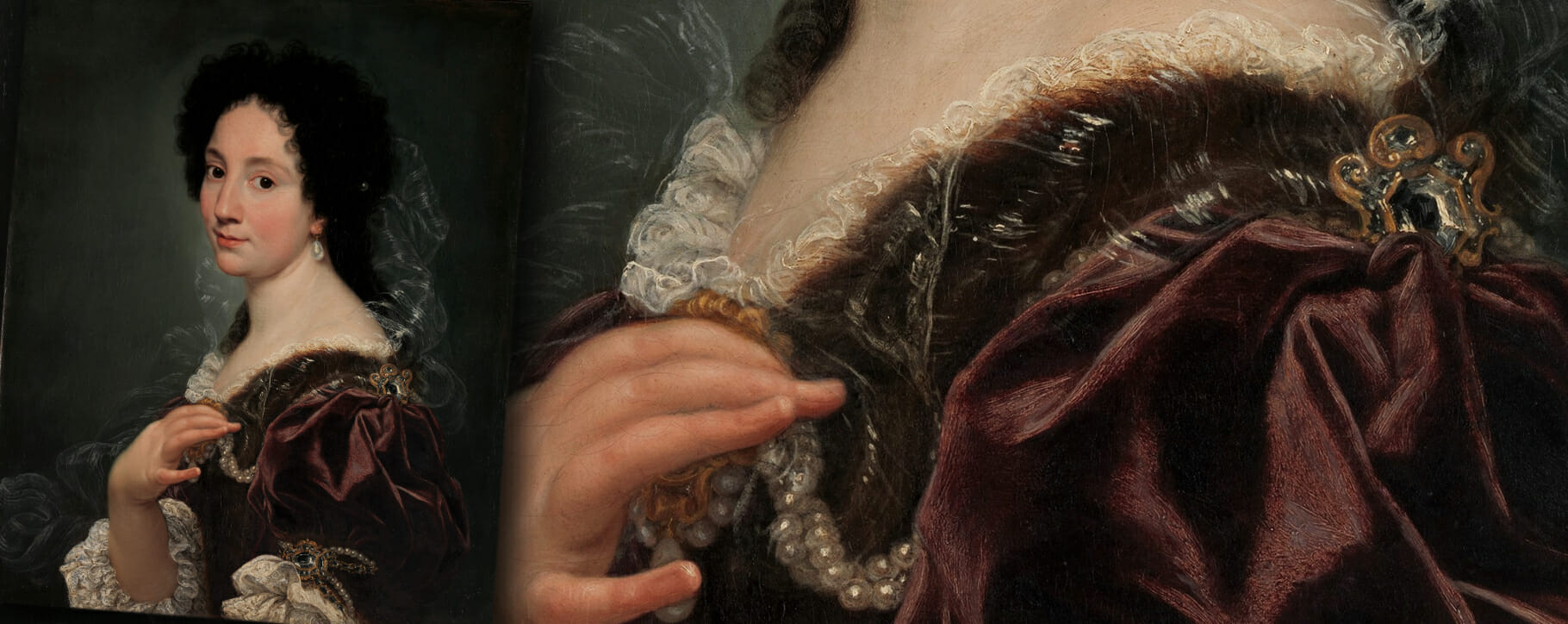 Above: a portrait from the 1670s by Giovanni Battista Gaulli displaying the use of lace later in the century
Above: a portrait from the 1670s by Giovanni Battista Gaulli displaying the use of lace later in the century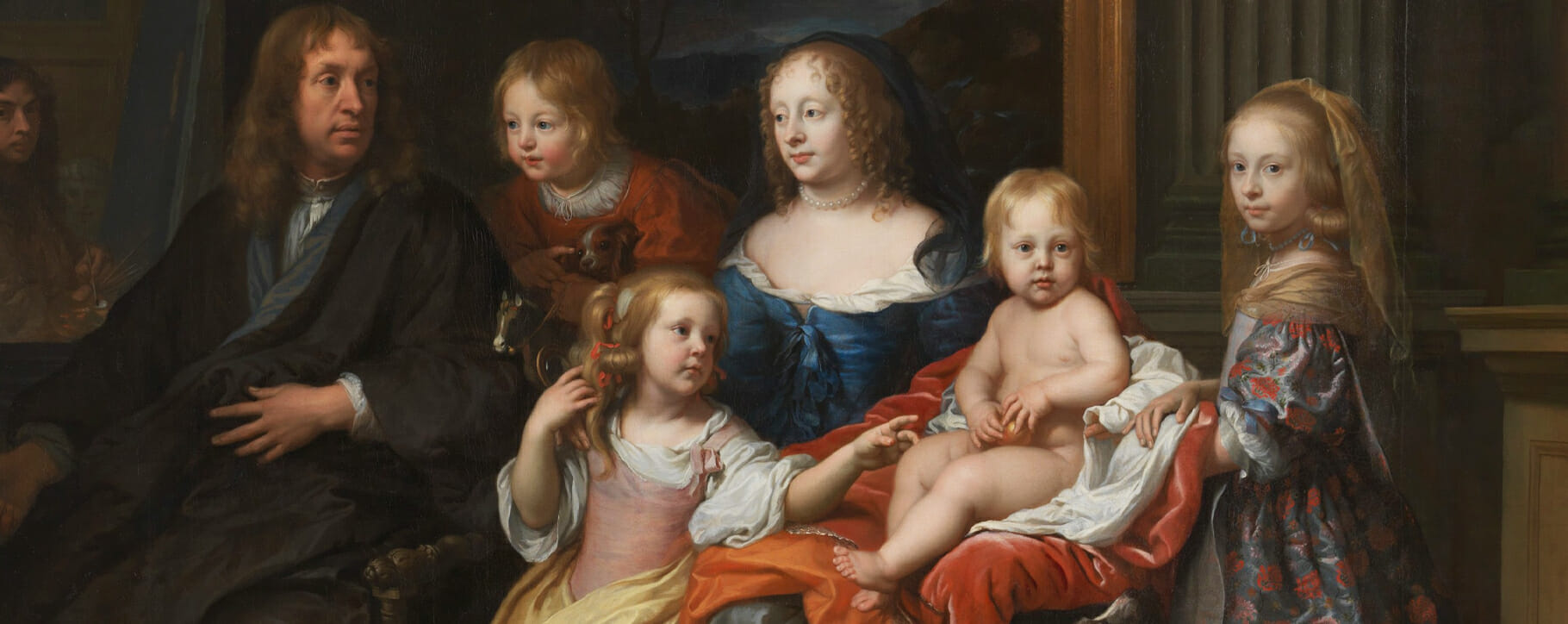 Above: a detail from a Dutch family portrait by Charles Le Brun from 1660
Above: a detail from a Dutch family portrait by Charles Le Brun from 1660 Above: a detail from van Dyck’s portrait of Lord Wharton from 1632
Above: a detail from van Dyck’s portrait of Lord Wharton from 1632 Above: a painting by van Dyck before and after being restored in our studio
Above: a painting by van Dyck before and after being restored in our studio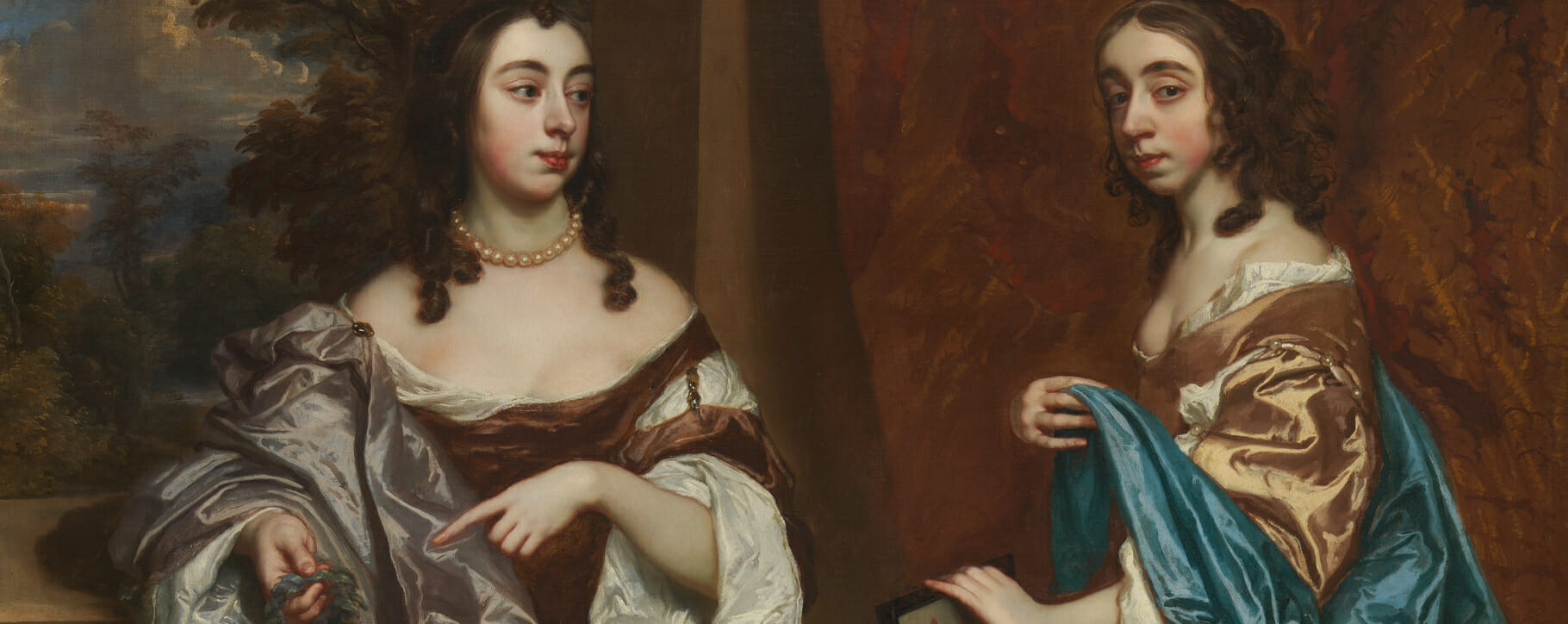 Above: a detail from Peter Lely’s portrait of Mary Capel, Later Duchess of Beaufort, and Her Sister Elizabeth, Countess of Carnarvon
Above: a detail from Peter Lely’s portrait of Mary Capel, Later Duchess of Beaufort, and Her Sister Elizabeth, Countess of Carnarvon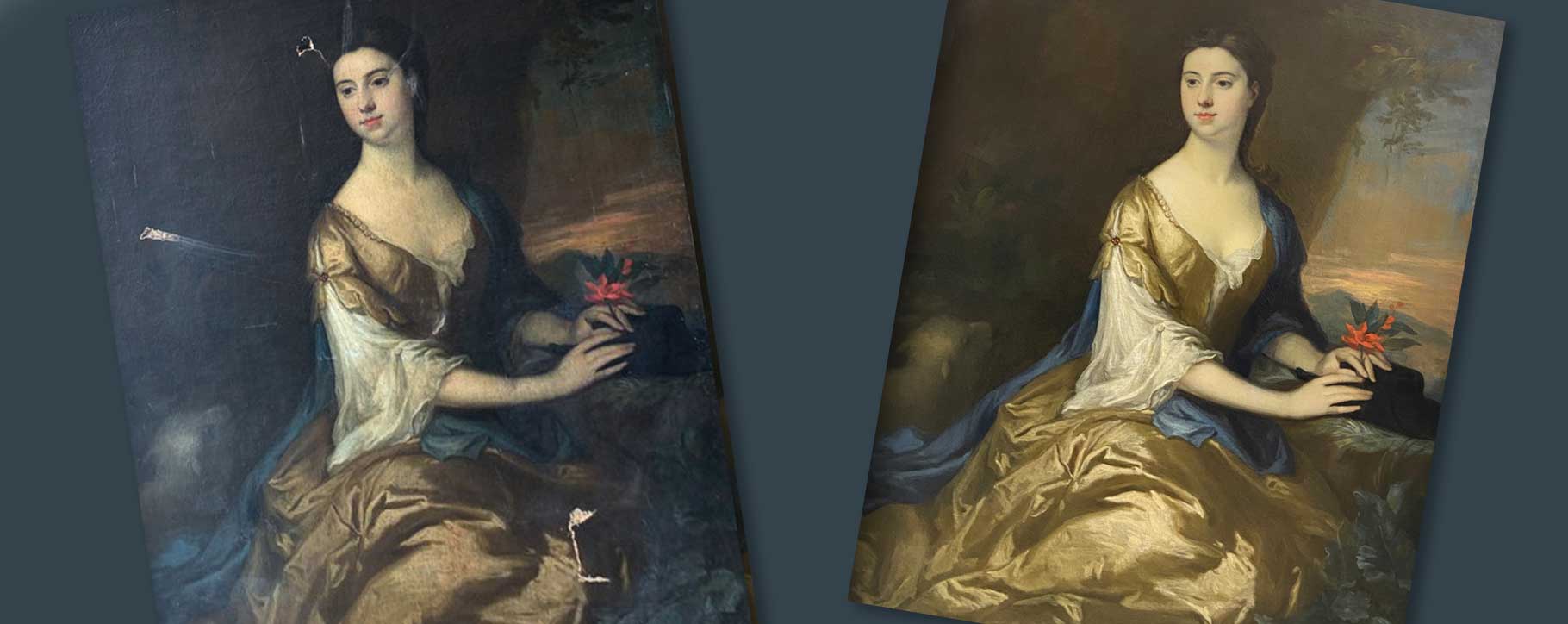 Above: an early 18th century Godfrey Kneller portrait before and after restoration by our conservators
Above: an early 18th century Godfrey Kneller portrait before and after restoration by our conservators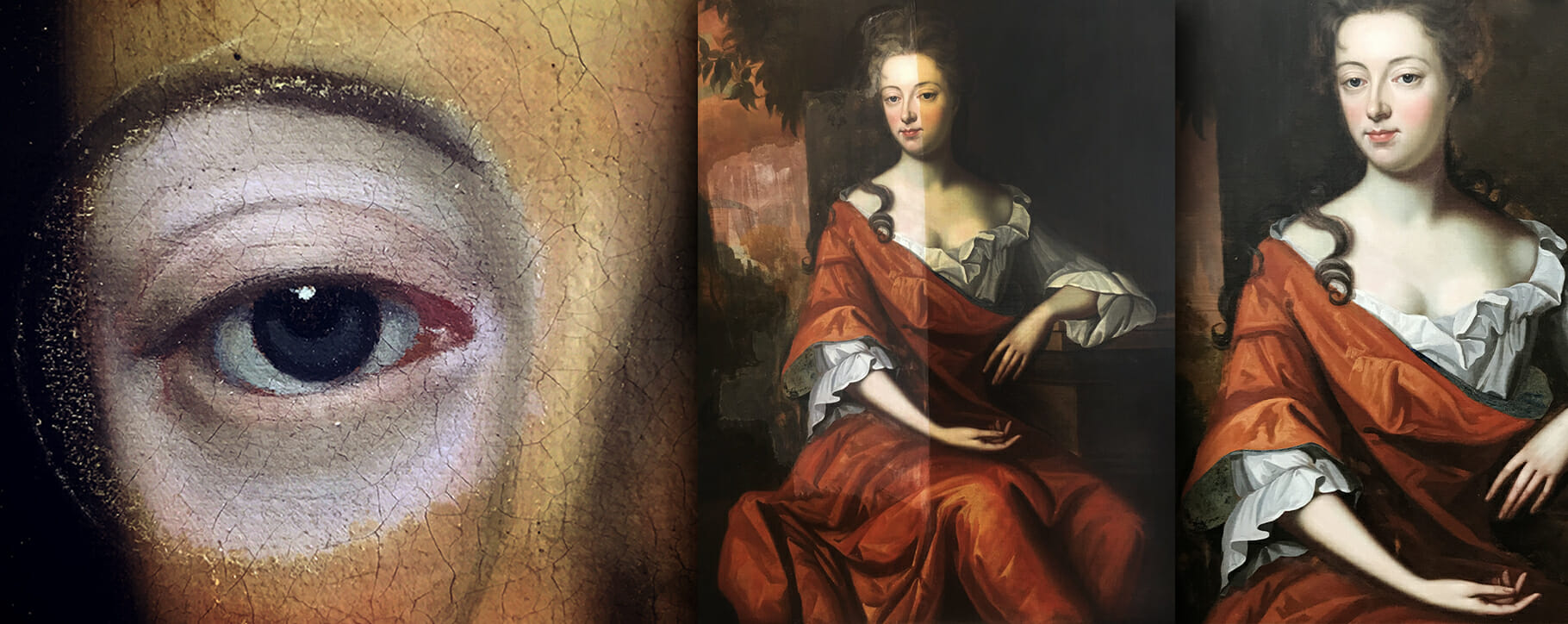 Above: a 17th century portrait restored in our studio, here you can see the difference following a varnish removal on a small area (left), halfway through (middle) and after (right)
Above: a 17th century portrait restored in our studio, here you can see the difference following a varnish removal on a small area (left), halfway through (middle) and after (right)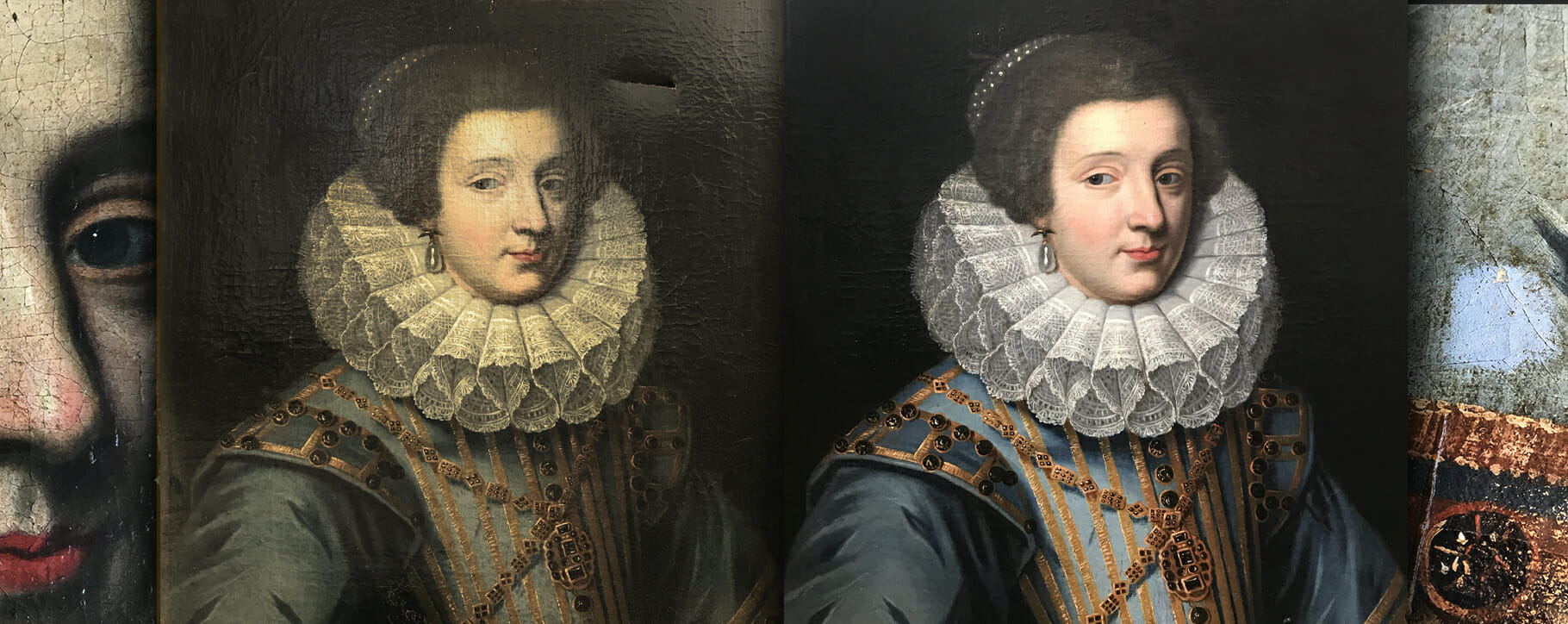 Above: a 17th century portrait restored in our studio featuring a tear to the canvas which was seamlessly restored
Above: a 17th century portrait restored in our studio featuring a tear to the canvas which was seamlessly restored 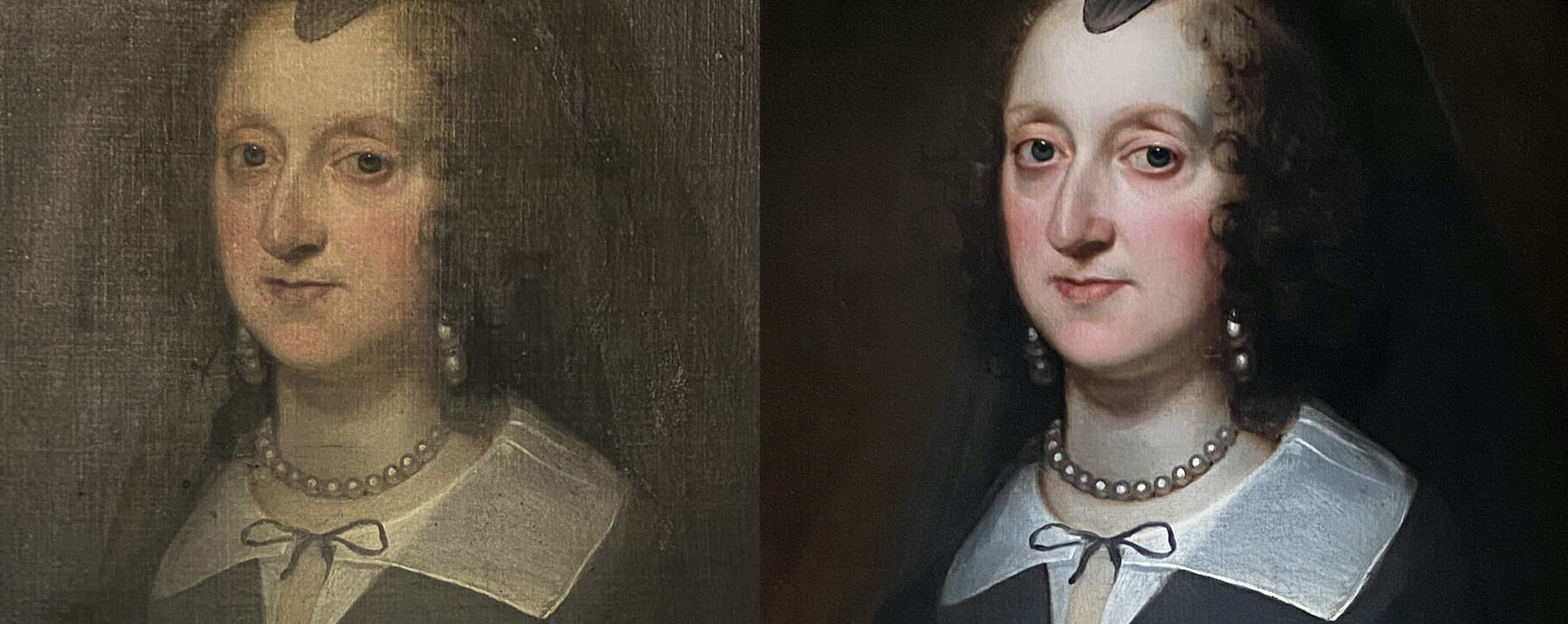 Above: a 17th century portrait restored in our studio due to smoke damage
Above: a 17th century portrait restored in our studio due to smoke damage 




